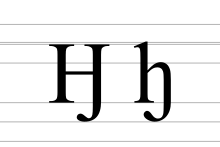| Heng | |
|---|---|
| Ꜧ ꜧ | |
 | |
 | |
| Usage | |
| Writing system | Latin script |
| Type | Alphabetic |
| Language of origin | Unified Northern Alphabet |
| History | |
| Development |
|
| Other | |
Heng is a letter of the Latin alphabet, originating as a typographic ligature of h and ŋ. It is used for a voiceless y-like sound[clarification needed], such as in Dania transcription of the Danish language.
Heng was used word-finally in early transcriptions of Mayan languages, where it may have represented a uvular fricative.
It is sometimes used to write Judeo-Tat. [citation needed]
Heng has been occasionally used by phonologists to represent a jocular phoneme in English, which includes both [h] and [ŋ] as its allophones, to illustrate the limited usefulness of minimal pairs to distinguish phonemes. /h/ and /ŋ/ are separate phonemes in English, even though no minimal pair for them exists due to their complementary distribution.[1]
Heng is also used in Bantu linguistics to indicate a voiced alveolar lateral fricative ([ɮ]).[2]
Both U+A726 Ꜧ LATIN CAPITAL LETTER HENG and U+A727 ꜧ LATIN SMALL LETTER HENG are encoded in Unicode block Latin Extended-D; they were added with Unicode version 5.1 in April 2008.
- ^ Hornsby, David (2014). Linguistics: A Complete Introduction: Teach Yourself. John Murray Press. ISBN 9781444180343.
- ^ Wells, John (3 November 2006). "The symbol ɮ". John Wells’s phonetic blog. Department of Phonetics and Linguistics, University College London. Retrieved 1 February 2018.
© MMXXIII Rich X Search. We shall prevail. All rights reserved. Rich X Search
